Today, April 14, marks the one year anniversary of the sinking of Russia’s Black Sea Fleet Flagship, the Moskva cruiser. Most people have long filed this event away as a closed case, that Ukraine destroyed the ship with missiles.
Significantly, for the anniversary of this event, Ukraine yesterday released what they claim to be the first ever footage of the firing of the Neptune missiles which purportedly sunk the Moskva. The video is claimed to be taken on April 13, 2022.
Full quality video can be seen here: Twitter Link.
Keep this daylight schedule in mind as you read this analyst’s take. @Fennec_Radar on Twitter writes:
I have always said that the story of Ukraine sinking the Moskva with anti-ship missiles was bull. Partly for technical reasons, but also because if they did indeed launch such an attack, they would have released footage of the missiles being launched, or the command team that operated the unit giving the order to launch or getting word of the impacts. But we never got anything. Despite how desperate Ukraine always is for propaganda victories, and this would have been their ultimate one after all.
But now a year later they finally release what they claim is footage of the launch of the pair of Neptune missiles that sank the Moskva.
Except there is one problem. Namely the fact that despite being overcast, it is still incredibly bright out. And considering the time for sunset in Odessa on the 13th of April is 19:41 (7:41 PM for thus unfamiliar with 24 hour clocks), that means this video had to be taken a fair bit before that time to have the lighting conditions we see.
Why is this bad? Well because the Moskva was supposedly struck during the night. The first message of that attack we get is at 20:42 (8:42 PM).
But the missile needed to take time to reach its target I hear you say. Well we can account for that. The Neptune is a Kh-35 derived missile so likely traveling at a similar average speed of 1000 km/h. With a maximum range of 280 km it would take about half an hour to reach that far. That still puts a potential launch after sunset. Even if you give the team an additional 30 minutes to celebrate before getting the message out, that would put the launch right at the time of sunset. But in the video we can see that this is still well before sunset.
So I believe the Ukrainians literally waited a year to have the right environmental conditions (cant film a spring video in winter) to stage this video. And then completely forgot to have the right time of day.
Now, allow me to present my thoughts. The following is a heavily updated version of my analysis from last year, published on The Saker’s site on April 18th, four days after the Moskva sinking. Once again I have more than doubled the length of the original with new contemporaneous additions which have been on my mind since that time. I believe it’s one of the only two articles of mine from that period worthy of reprint and documentation for the collective record, since The Saker site has been taken down.
As I said, I’ve updated the article with a lot of new thoughts, details, and clarifications. Without vanity, I believe to this day this is the only existing serious attempt at analysis of this event which truly seeks to delve deeply into what happened by way of impartial reasoning and logic rather than simple stenography of the surface-level mainstream narrative and other basic lies from Kiev.
Wednesday, April 13, 2022
Let’s start with the official Ukrainian report of the incident’s timeline:
Ukrainian account:
The first known report of a missile hitting the ship was at 20:42, 13 April 2022 Ukrainian time (EEST, UTC+03:00) with a Facebook post by a Ukrainian volunteer connected to the military:"The cruiser Moskva has just been hit by 2 Neptune missiles. It is standing [not sunk], burning. And there is a storm at sea. Tactical flooding is required, apparently." Later that evening presidential adviser Oleksiy Arestovych reported Moskva was on fire in rough seas and Odesa governor Maksym Marchenko officially confirmed that Ukrainian forces hit Moskva with two R-360 Neptune anti-ship missiles, which "caused very serious damage." At 12:43, 14 April EEST, the Ukrainian Southern Command posted a video on Facebook with a report stating the ship had received damage within the range of the Neptune anti-ship missile, there was a fire and other vessels in Moskva's group "tried to help, but a storm and a powerful explosion of ammunition overturned the cruiser and it began to sink."
So, firstly, according to them, the missiles first hit at 20:42 or 8:42pm. The missile is said to travel at Mach 0.8 or 900km/h. The location of the hit is roughly shown here, as per several sources including the official U.S. military account, which gives the precise coordinates at the time of the ‘incident’ as 45°10′43.39″N 30°55′30.54″E:
The distance from that area to Odessa is roughly 120-130km, and this exact distance was later confirmed by U.S. military sources as being the distance from the alleged ‘missile launcher’.
My calculation is that a 900km/h missile takes only 8 minutes to travel 120km, which is even much less than Fennec’s observations printed earlier. Given the daylight chart shown above, Sunset was at 7:41pm. The missile hit at 8:42pm as per Ukraine’s own words above. That means for an 8 minute flight time, the missile would have had to be launched at roughly 8:34pm. This is almost an hour after sunset. In fact, the sunset chart above even says that ‘Twilight’ is at 8:12pm. Does the video of the Neptune launch they posted appear to be an hour after sunset, and roughly half hour after the beginning of twilight? Debatable, I suppose, but not to me—it should presumably be much darker, if not total nighttime at that point.
Also, the official Ukrainian story is that there was a severe storm at sea, which could have contributed to the Moskva’s radars not seeing the missile from the wavetop clutter. Does it look like stormy conditions in the launch video above? Granted, that’s the shoreline and the ship was 120km or less away, but I’m not sure there could be that much difference in that distance.
At 10:59, 14 April 2022 [EEST], the Lithuanian defense minister, Arvydas Anušauskas, reported on Facebook that an SOS signal was sent at 01:05, the cruiser rolled onto its side at 01:14, and the electricity went out half an hour later. "From 2 a.m., a Turkish ship evacuated 54 sailors from the cruiser, and at about 3 a.m., Turkey and Romania reported that the ship was completely sunk." According to the Albanian website Politiko, a Turkish official denied to BBC News that a Turkish ship rescued any Russian crew.
The first SOS signal according to Lithuanian DefMin came at 1am in the morning, which would be highly improbable if the ship was hit 5 hours earlier. Secondly, it seems to beggar logic that within ~45 minutes of the SOS, a Turkish ship had already fully evacuated the ship. The Moskva was all the way in the north of the Black Sea, a Turkish ship would take hours to cross to that region. It’s 400km from the Turkish shores to the area and most ships travel at around 20-40km/h at most. Sure, a Turkish ship could have been somewhere nearby by coincidence, but it’s unlikely that far north.
One important thing to note is that, one of the chief points of ‘evidence’ from the Ukrainian side is the claim that Ukrainian sources were the first to report the ship being on fire in the Black Sea. My contention is that, since the Moskva would have immediately sent out SOS signals, and since we know those signals were picked up by Turkey—a NATO member—who later helped rescue Russian sailors, then clearly this information would have gotten through NATO and to Ukraine almost immediately.
However, the fact that the Ukrainian claim of being ‘first’ is premised on a post by an AFU servicemen at nearly 9pm shoots holes in their story because, as we’ll see below, it appears the timeline could very well have been much earlier.
Here is one of the only extant photos of the Moskva after its ‘incident’. This image was reportedly taken and leaked from aboard the Turkish ship that answered the SOS call and helped rescue some of the sailors:
We see here that it’s light outside, so clearly something in the ‘official’ timeline is way off. It could be the next early morning of April 14, perhaps, though Western sources claim the ship sunk overnight. The only logical explanation then is that the ‘incident’ must have occurred much earlier in the evening than claimed above, which would mean that Ukraine’s celebratory post at 8:42pm would not be as ‘early’ as they make it out to be.
If the ship was already being evacuated AND had tugs attached, which could have taken hours to reach it, and yet it’s still LIGHT outside as per the above photo, that means the actual explosion could have occurred many hours before 8:42pm. This would give many hours for Ukraine to ‘find out’ about the incident via NATO responses to Russia’s SOS, putting their claims of ‘being first’ to know about the ship incident in grave doubt.
Also, it should be stated that the official Western story that the Moskva sunk during the night is constructed to deliberately support Ukrainian claims that the incident was more ‘catastrophic’ than it looked, and that all the sailors died. But Russian sources did not report the actual sinking of the ship until late the next day, April 14th. That means the Moskva could have theoretically been afloat for nearly 12 hours or more, which jibes with the photo showing the ship in daytime conditions. This version would be inconvenient for the West/Ukraine because it makes the story of Russian sailors surviving more probable, by the simple fact that Russia would have much more time to evacuate them.
You could argue that it also calls into doubt the “double missile hit” into the ship, as the entire incident would appear less ‘catastrophic’ in nature if the Moskva in fact had its fire entirely under control as Russian MOD insists, and stayed afloat for such a long time.
Either way, the full timeline is clearly difficult to make out because of the discrepancies described above, but it goes to show that the official timelines given by the West are very unreliable, and should not be trusted at face value.
But back to the photo above. Upon cursory glance, this seems like a typical/likely missile strike. Center midships hit, portside list of ship, burn and explosion marks, etc. However there’s a few major problems that few have brought up.
Firstly, the burn marks you see along the portside hull are clearly smoke and fume exhalation points along the ports which dot the hull. The larger burn marks which are slightly lower on the hull are larger ports, some of which may be for torpedo tubes (a special kind of torpedo that slides out and drops into the water):
This can clearly be seen in a reference photos of the ship:
The large lower port holes can clearly be seen in the red circles.
So, none of those black marks on the ship appear to be from any missile hits, they are merely any open ports and torpedo slots emitting fire from the inside of the ship and burning/blackening the hull around them. You can see the red circles line up from both before and after images of the ship.
Compare:
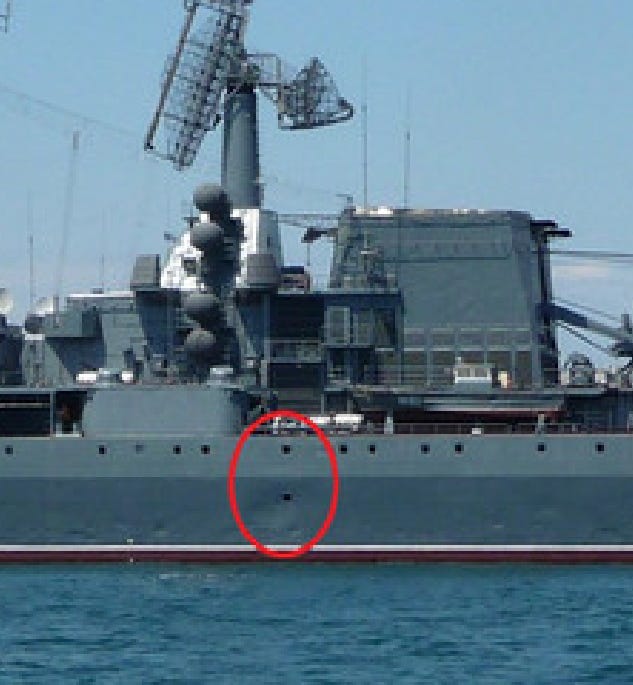
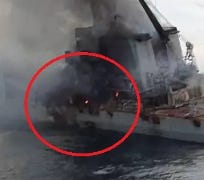
In the photo of the damaged ship, the large red circle clearly implies the area where a missile is assumed by most to have hit, as there is a much larger blackened area there.
But there is no clear sign of destruction, the blackened area appears to be roughly similar to the torpedo tube circled in red on the (left) photo above. In that center area there are ammunition departments plus power plant, so clearly an explosion from inside could have happened and blackened that area more.
Keep in mind, one of the earliest claims to being a missile hit was supported mainly by an AI modified image that was being passed around which intended to “enhance” the photo above to make the hit area more visible:
Many people misunderstood what this image was, and assumed it to be a real close up of the hit and were therefore misled into confirmation of the ‘missile theory’. But in fact, it’s merely an AI generated ‘cleanup’ that makes it look like there’s a large hole where there really isn’t.
An actual real closeup and slight cleanup in terms of brightening of the original photo is as follows:
Does that look like two massive, truck-sized anti-ship missiles with 350lbs warheads each slammed into the centerline of the ship?
Let’s take a look at some historic examples of real, proven anti-ship missile hits to compare. Here’s when the Sheffield was hit in the Falklands War:
You can see the damage on the side.
And here’s some images of the USS Stark when it was hit by an Exocet missile fired by an Iraqi plane. Actually, both HMS Sheffield and Stark were hit by Exocets, and this missile is similar in size to the Neptune that Ukraine allegedly used.
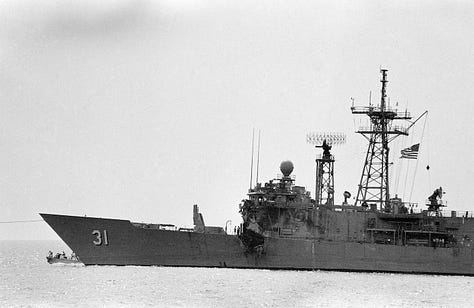
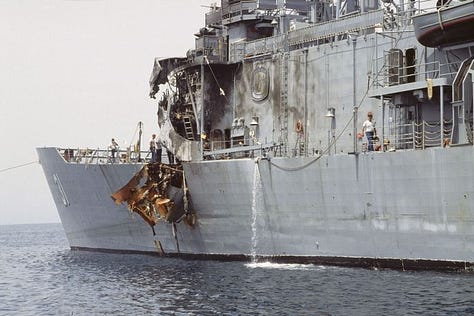
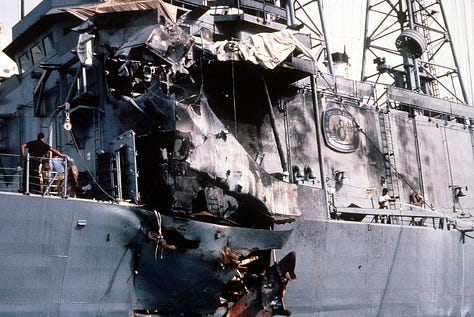
And here’s some examples of an Indian Brahmos missile test against one of their own ships:
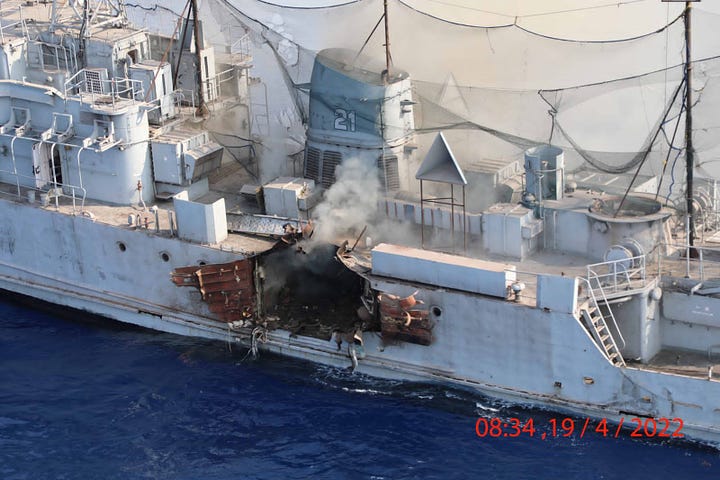
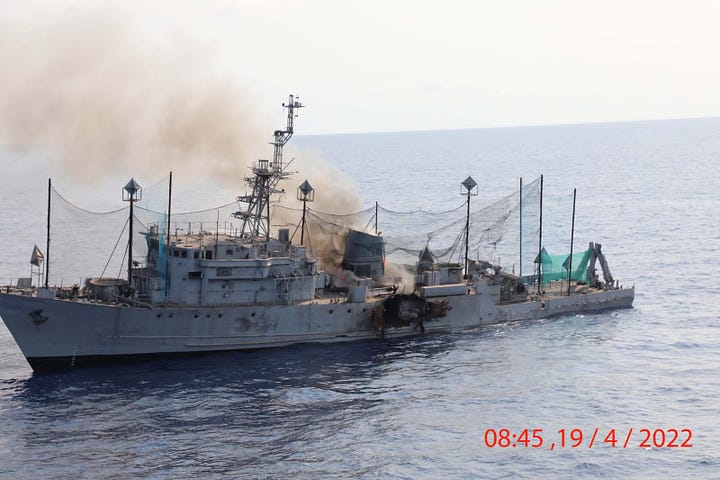
The difference is quite clear: there is massive damage seen, with an outward spalling eruption of metal caused by the internal explosion. The way these missiles function is they have a delayed fuse which causes them to first pierce the hull, and then explode deep inside the ship for maximum internal damage. This causes an ‘outward’ mushrooming damage model to the ship hull, which is not seen at all in the Moskva. Only intense burn marks that are also visible from every porthole along the hull going aft.
Keep in mind, it’s “confirmed” both by Ukraine and the U.S. as per their official narrative line, that specifically two Neptune missiles were not only fired, but hit the ship. This language is clear in their reports. Do you see evidence of not one but two of such massive missiles tearing the Moskva hull outward in such a way?
On 15 April, a senior US Defense official said that Moskva had been hit by two Neptune missiles; he also stated that the ship was about 65 nmi (120 km) south of Odesa when she was struck and that the cruiser continued onward under her own power before sinking on 14 April.
One could argue that a large hole is perhaps hidden by the waterline as the ship is clearly listed heavily to the port side. But it would seem to me that we would still see the top of the hole and outwardly-spalling metal much more clearly. These sea-skimming missiles do skim the sea at about 50ft then drop a little lower at terminal phase, BUT they don’t drop THAT low where they’re literally on the water line.
One website’s description of the missiles:
“The Neptune missiles are fired from a truck on the ground. After its initial launch, the missile starts lowering down over the seawater to an altitude of about 10-15 m. It continues lowering down until reaching just 3-10 m above the wave crest before reaching its target.”
3-10m is 10-33ft.
As can be seen from the Sheffield and Stark hits, they hit the hull at roughly 15-20ft up above water, not at mere inches over the waterline. They can’t be programmed to go TOO low on account of waves, otherwise they might strike a wave in stormy seas, wasting the missile.
But these things could be debatable thus far. Here are some even more interesting findings:
1. Firstly it has been noted by experts that in the Moskva photos, ALL life boats are missing which means they were deployed, which means already the Ukrainian side is caught in one lie because it means the sailors were in fact saved. The crane can even be seen in a sideward, non diametric position which means it was used to lower lifeboats to the water.
The pink-colored circle shows the lifeboat crane in deployed position above, compared to stowed position in the stock photo below. The light blue circle in the bottom photo shows lifeboats, in the above photo they’re all missing, proving that the crew was saved. Ukraine’s official report to this day is that most or ALL of the crew ‘died’.
If you are caught in one lie, the trust coefficient for the rest of your claims goes down immensely.
The yellow circles above also show the rear hangar door where the ship’s Ka-27 helicopter is housed. It’s likewise seen as open, which means the helicopter is out and was used to ferry people to safety, further proving the above point.
2. The last known satellite photos of the Moskva show it oriented with bow facing south/southeast, and its portside facing east.
This photo is from 2300 hours of April 12, the Moskva was hit some hours later the next day. The Moskva was supposedly stationary like many of the Russian frigates in this region. It would be impossible for Ukrainian missiles coming from the direction of Odessa NW to hit the portside which is here facing east.
Here’s another source of the last known photos of the ship.
Note the direction of Odessa and where the missiles would come from, then note the orientation of the ship and its later-to-be-damaged portside.
3. Now here’s where it gets even more interesting. The green circle on the original photo I posted shows the Top Dome 3R41 Volna phased array fire control radar which is used to guide the ship’s S-300’s:
This radar has been noted by naval experts to be in the ‘standby’ or neutrally stowed rearward facing position. You can check hundreds of photos/videos of the Moskva in transit on the internet, and the radar always faces rearward in the stowed position when it is not in use.
But when it engages a target, it pivots and orients towards the target. So this suggests that during the hit of the Moskva, the fire control radar was not engaging any targets. Of course western ‘analysts’ say this means the Moskva was struck blind by their wunderwaffen stealth missiles and never saw them coming.
But, there’s a major, critical problem with that theory:
Their own story is in fact that the Moskva was “distracted” by multiple Bayraktar TB2 drones used as decoys, which the Moskva was targeting as it failed to notice the magical Neptune missiles broadside it. Here’s a graphic from their own tall tale:
You notice something I circled in red on their own graphic? They themselves are showing the fire-control radar pointing in the direction of the phantom TB2s in this hypothetical mockup. That means according to their own theory, in order to have successfully ‘distracted’ the Moskva as they claim, the fire-control radar dome MUST have been kept busy by the TB2s, yet clearly it remained in the standby peacetime position.
Using logic, no matter how you explain it, the Ukrainian side must be lying in at least one part of their statement. Either no TB2s were used and in fact a “stealthy” Neptune just happened to hit the Moskva with zero warning. OR: they were used to distract and the radar should have been tracking them. But then why would you believe the second part of their statement about the Neptunes being used when they clearly lied about the TB2 decoy usage as proven by the radar’s stock position?
Also, it should be stated that Ukraine was caught in another lie where they stated the ship sank right away (which serves their narrative of all the sailors dying), and that Russian MOD reports of the ship being ‘towed back to port’ were themselves a lie.
However, one thing most people missed in the famous photo of the damaged Moskva, is that on the starboard side, you can clearly see a tug is attached to the ship, helping to right it and spraying water on the fires.
I added the blue lines for clarity, you can see the masts from the other ship on the Moskva’s opposite side, and the jets of water it’s spraying.
And by the way, there is some chance one can possibly believe that a sea-skimming missile might bypass radar, but there is no chance a high flying TB2 (and multiple of them at that) will go undetected. And anyway, they admitted they were detected because they were “distracting the Moskva” radar operators according to the official story.
Here’s another mockup:
Notice the deception in how sneakily they reoriented the Moskva so that its portside faces Odessa in precisely the vector that would allow the missiles to hit that side. Yet as posted earlier, we know from the last known satellite image that Moskva was not facing that side at all. This is the type of subtle deception that goes into the fake Western ‘narrative’ of this tall tale.
Also, if you zoom in on the original damaged Moskva photo, it can be seen that the S-300 tubes in the back are all closed, so we do know for definite no S-300 was fired. And of course, this corroborates the 3R41 Volna Radar dome being in offline stowed position, as that is the S-300 fire control radar.
You really think if the Moskva was being ‘distracted’ by multiple TB2s it wouldn’t have fired some S-300’s at them?
Now consider the following:
If Ukraine really had the capability of using Neptune missile to hit the Moskva, why would it only use 2 and allow the Moskva to still stay afloat for almost a whole day afterwards, being towed to base? Even in the photo the Moskva is cleared of crew and unprotected, why couldn’t Ukraine continue firing to finish it off in that moment of uncertainty?
And further, why couldn’t the magical TB2s also rain down their own missiles on the now crippled and de-crewed cruiser to finish it off?
If TB2s were in the air, where’s the footage? Ukraine loves posting any possible footage of their use, so how come there’s no glorious high-def footage of Neptune missiles slamming into the ship from the perspective of the TB2s magnificent Canadian-manufactured cameras/optics? And why is the radar in a position that clearly shows it wasn’t tracking anything in the sky?
Why wasn’t every other Russian ship in the area destroyed by these magical Neptune missiles that even the Moskva’s powerful 5+ radar systems couldn’t detect? The area was swarming with other Russian frigates and tugs both during and after the hit. Why weren’t they all finished off by these unstoppable Neptunes? The official Ukrainian report pasted at the beginning states the Moskva was surrounded by several other vessels of its grouping. Wouldn’t they all be easy to finish off?
The most condemning point of all: why hasn’t Ukraine ever been able to replicate this miraculous feat? If its Neptune missiles are so unstoppable, why has it been a whole year and not a single other Russian ship has yet been hit with them? The Moskva had 5+ different radar systems, most smaller Russian frigates and corvettes have far less, and less powerful ones to boot. They should theoretically be sitting ducks. Why hasn’t Ukraine totally wasted the entire Black Sea fleet by now, or at least even attempted to do so with these missiles?
It all boils down to this fact: that if Ukraine lied about even one part of the story, such as the TB2s—which clearly is the most debunked part of the tale—then why would any other part be believable? It stands to reason they would lie about anything and everything else.
And the photo also proves they lied about the 450 dead sailors because we know every single lifeboat was deployed, as not even one is visible on the ship, which clearly suggests the vast majority, if not all, of the sailors survived. This includes the Ka-27 helicopter which is also seen to be deployed. Russia showed off hundreds of the sailors, anyway, at a later parade and then admitted to the total losses, which officially are 27 crewmen.
(Video of Moskva alive sailors re-enlisting)
Further, the damage seen is clearly not representative of two massive Exocet-sized missile strikes which would have gutted the hull. It looks like burn marks from an intense fire pouring out of the ports and torpedo slots due to some internal detonation that gutted the inside of the ship right at that midway point, beneath the smokestacks where the engine room lies. And big surprise – this was exactly the Russian MOD’s original explanation. The official line to this day is that the ship suffered an internal ammo fire and detonation.
Conclusions
So if it wasn’t a missile, what caused it then? Andrei Martynov had some good suggestions in his video after the incident, particularly the sabotage part, which I’m inclined to agree with. Considering the ship was stationed in Sevastopol with sailors who might have clear connections via family to the Ukrainian side of the conflict vis a vis Crimea, there could have been a vindictive sailor apt to pay Russia back for Ukraine, particularly one paid off by the SBU. Now that a year has passed and we’ve seen how often SBU operatives pay off even Russian citizens like Daria Trepova, who recently killed Vladlen Tatarsky, in retrospect it’s no longer hard to believe that this could have very easily happened with the Moskva.
And as Martynov explained, setting something on fire in the internals of the ship leading to a catastrophic explosion would be quite rudimentary for someone in the know. After all, it has happened many times in other navies, including in the recent past for the U.S. (https://www.theguardian.com/us-news/2021/dec/14/sailor-charged-over-fire-that-destroyed-us-warship-disgruntled-prosecutors-say) when a disgruntled sailor completely demolished the USS Bonhomme Richard, causing $3 billion in losses.
There are other possible explanations. Such as a sea-mine or naval drone, or underwater frogmen operations utilizing U.S. Seals or British Special Boat Service. After all, GrayZone exposed secret documents showing how the British were planning for Ukrainian divers to take out the Kerch Bridge pylons: https://thegrayzone.com/2022/10/10/ukrainian-kerch-bridge/
Ultimately, it is still a possibility, remote as it may be, that the Moskva was hit with missiles—I don’t discount anything. But look at the facts presented above and make up your own judgments.
To me, the facts clearly point towards Neptune missiles not being the cause, particularly in light of the aforementioned points of consideration I brought up, such as why has this act never been repeated on any other Russian ship, if these missiles are so deadly and unstoppable? The entire Black Sea Fleet should be a flaming wreck, or at least multiple other reports of attempted missile strikes—whether successfully defended or not—should have been seen by now. However, apart from this one ‘fluke’ strike, the missiles were never heard from again.
How believable is that?
And lastly, there isn’t a whole lot of historical precedent and visual evidence of real anti-ship missile hits in combat, but the few that we do have look nothing like the damage we see on the Moskva. Compare the USS Stark to the Moskva one last time.



One has massive gouges ripped out of the hull, the other just looks like a large burn mark from the fumes. And where is the second missile hit? They tell us that two missiles definitively struck the cruiser. Are we to believe they both went into the same exact hole, perfectly aligned? That alone is a devastating mark against the missile strike theory.
Also, as a last point: the only remaining possibility for the missile strike theory is that the large ‘hole’ is below the waterline and thus unable to be seen. But think about this: in the Stark, Sheffield, and Indian ship examples given above, the gigantic gouges in the ship’s hull are all very high above the water line, allowing those ships to remain afloat.
But if the Moskva has a giant hole of that size which is conveniently ‘hidden’ beneath the water line, would the ship really be able to stay afloat for another 12+ hours, being towed halfway to Sevastopol? A hole 30 feet across completely beneath the water would flood the ship immediately, resulting in its foundering. You can’t have it both ways.
Well, tell me what you think, and let’s remember the legendary Moskva on this anniversary date.
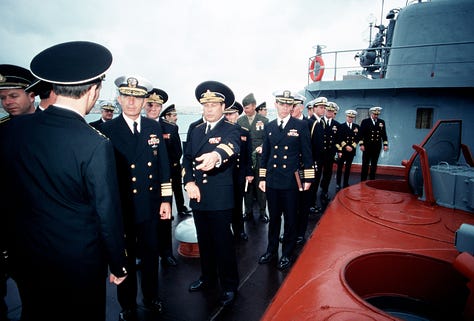

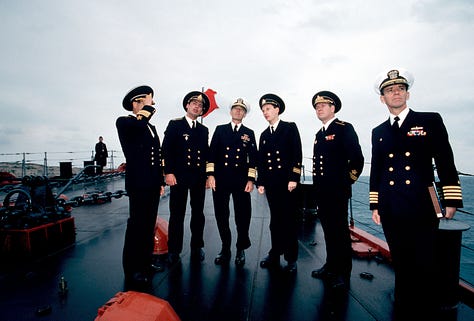
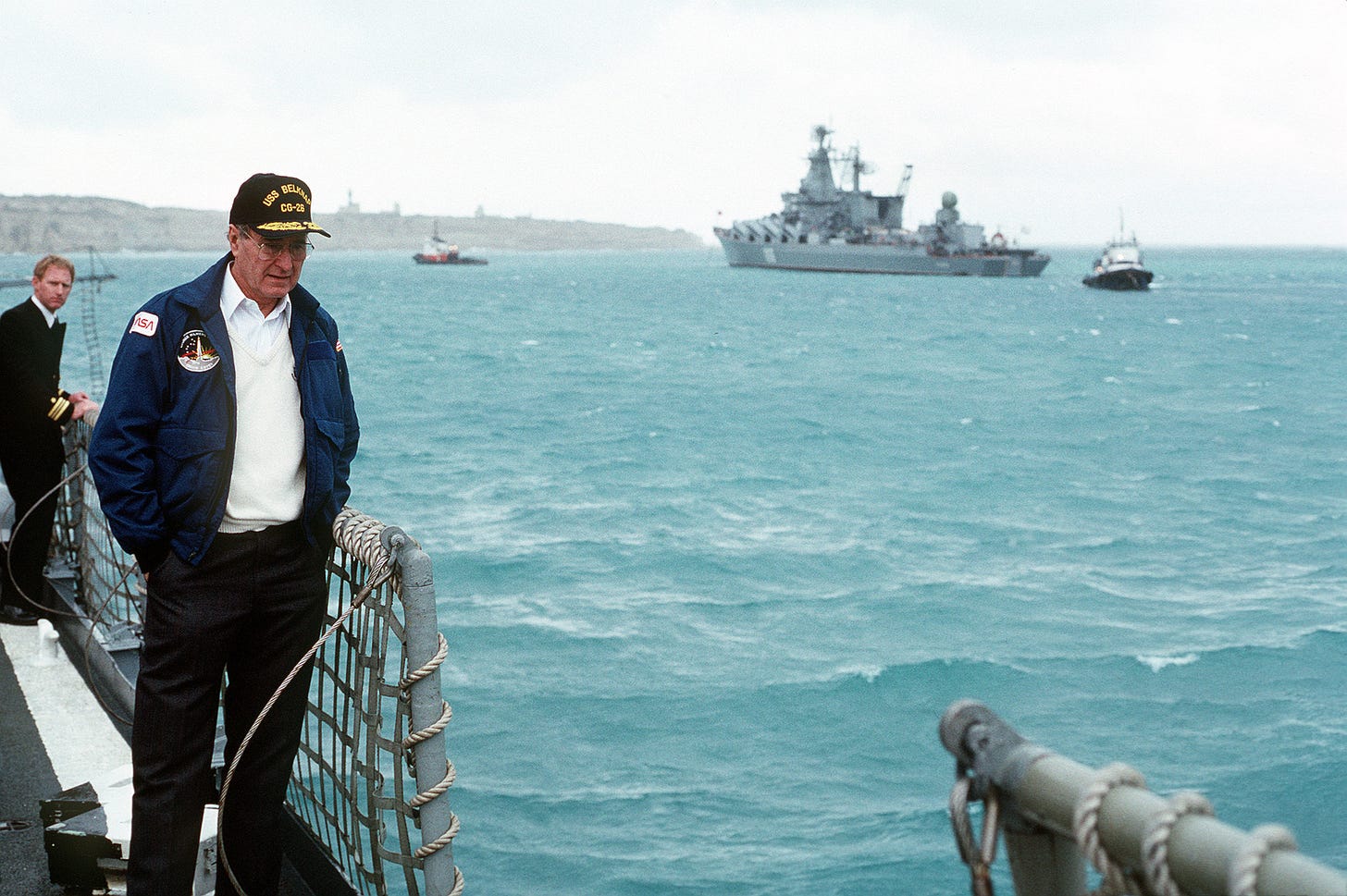
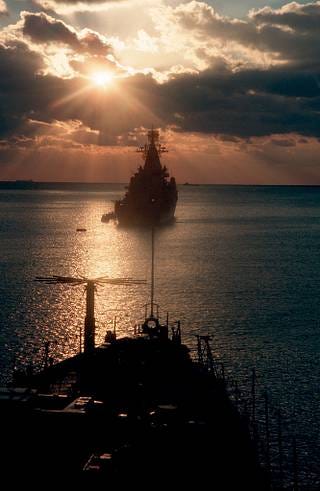
If you enjoyed the read, I would greatly appreciate if you subscribed to a monthly/yearly pledge to support my work, so that I may continue providing you with detailed, incisive reports like this one.
Alternatively, you can tip here: Tip Jar






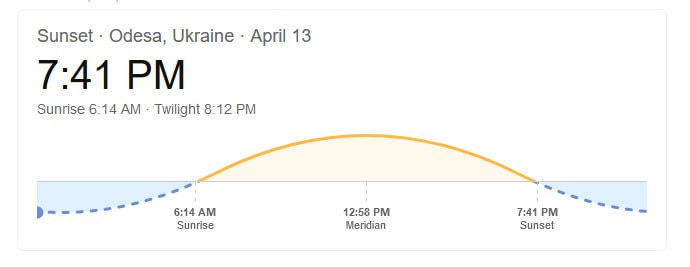
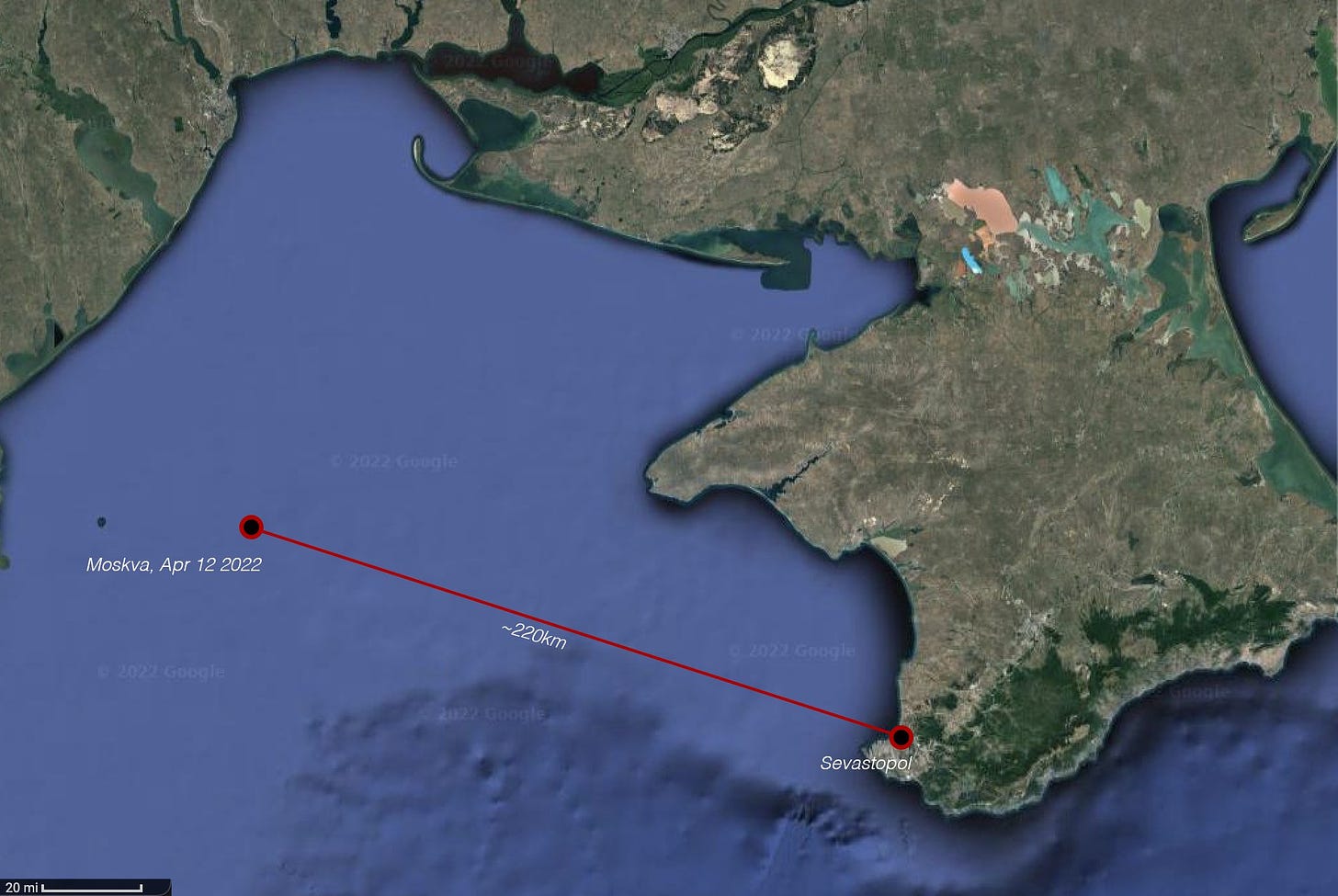
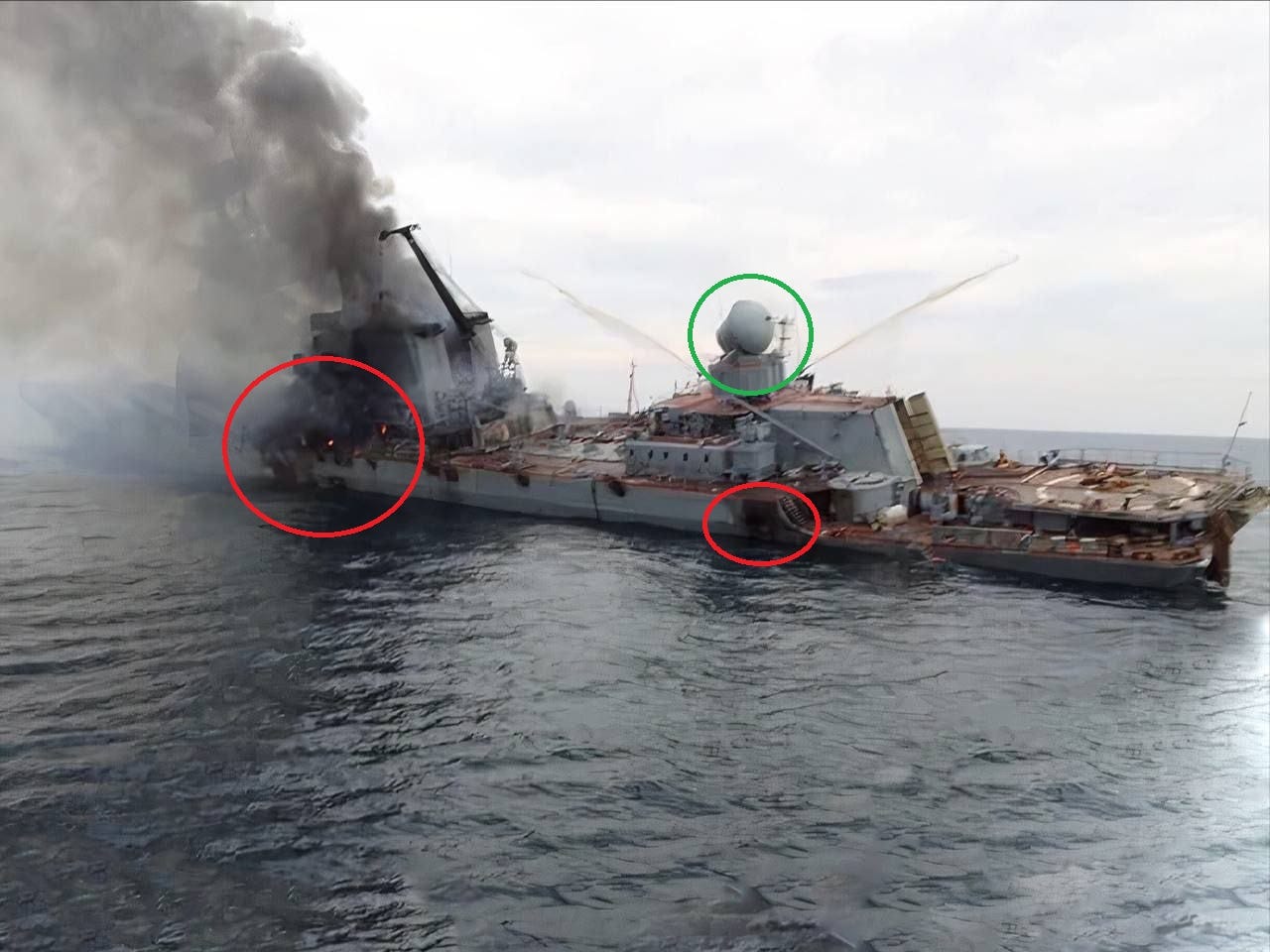
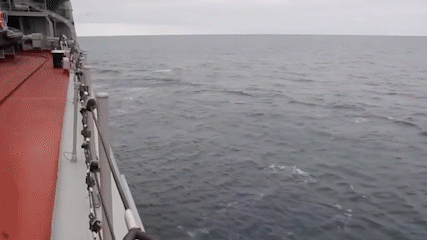
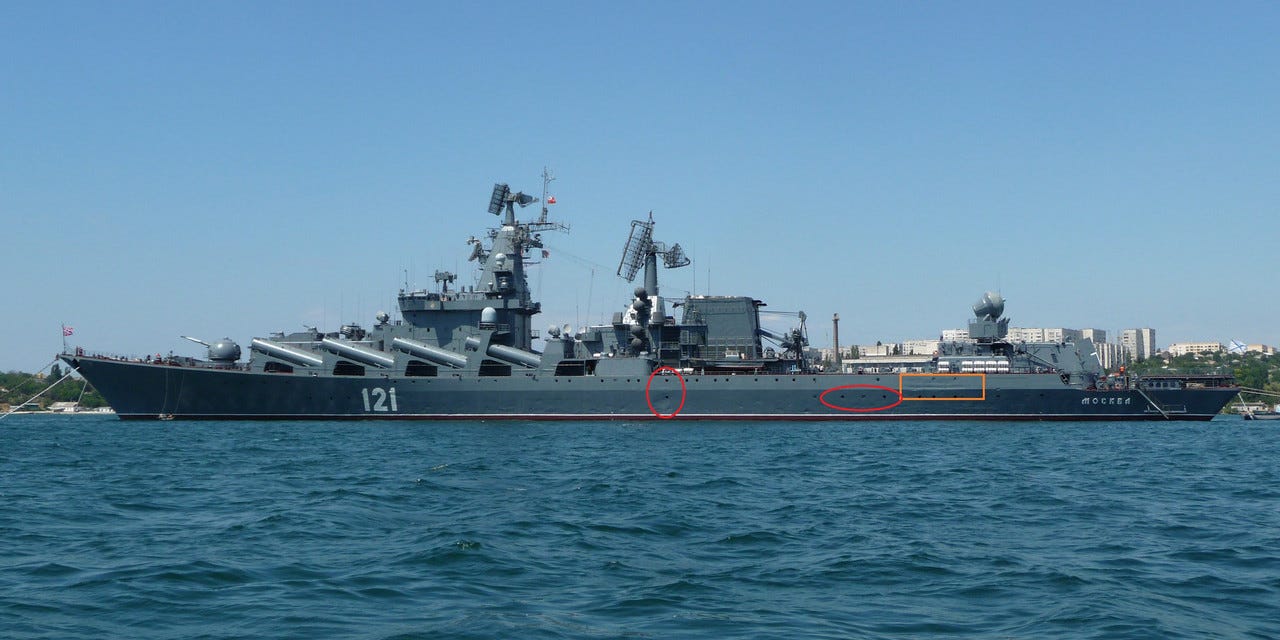

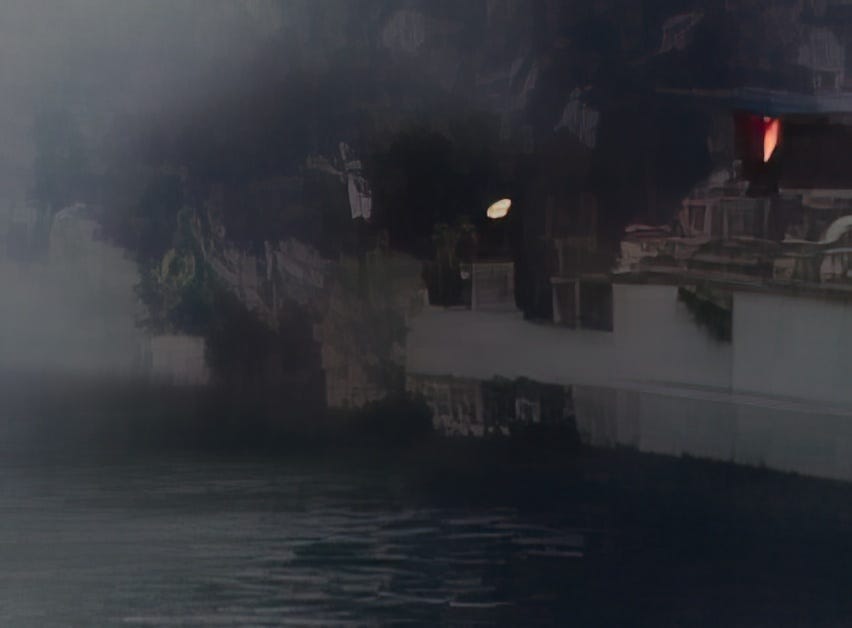
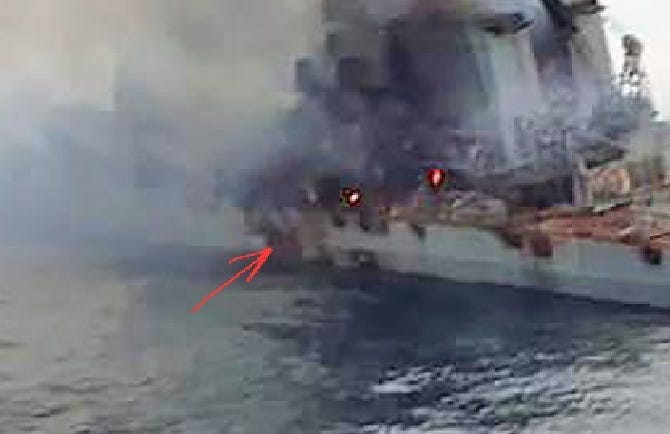
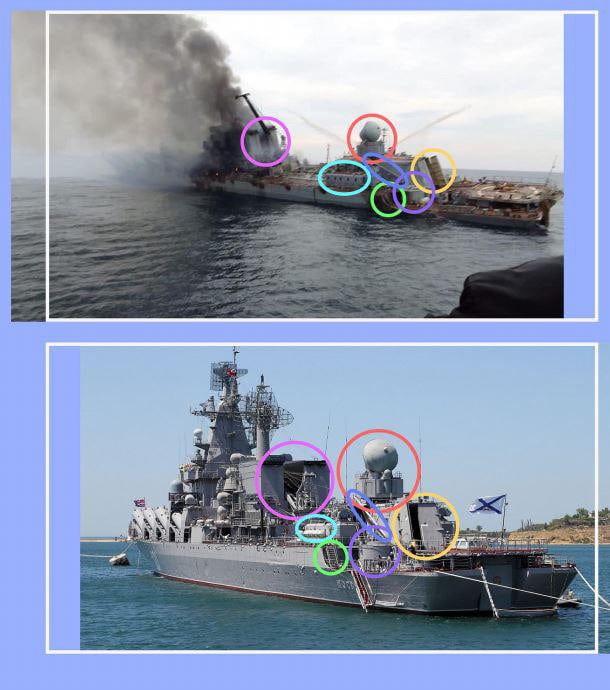
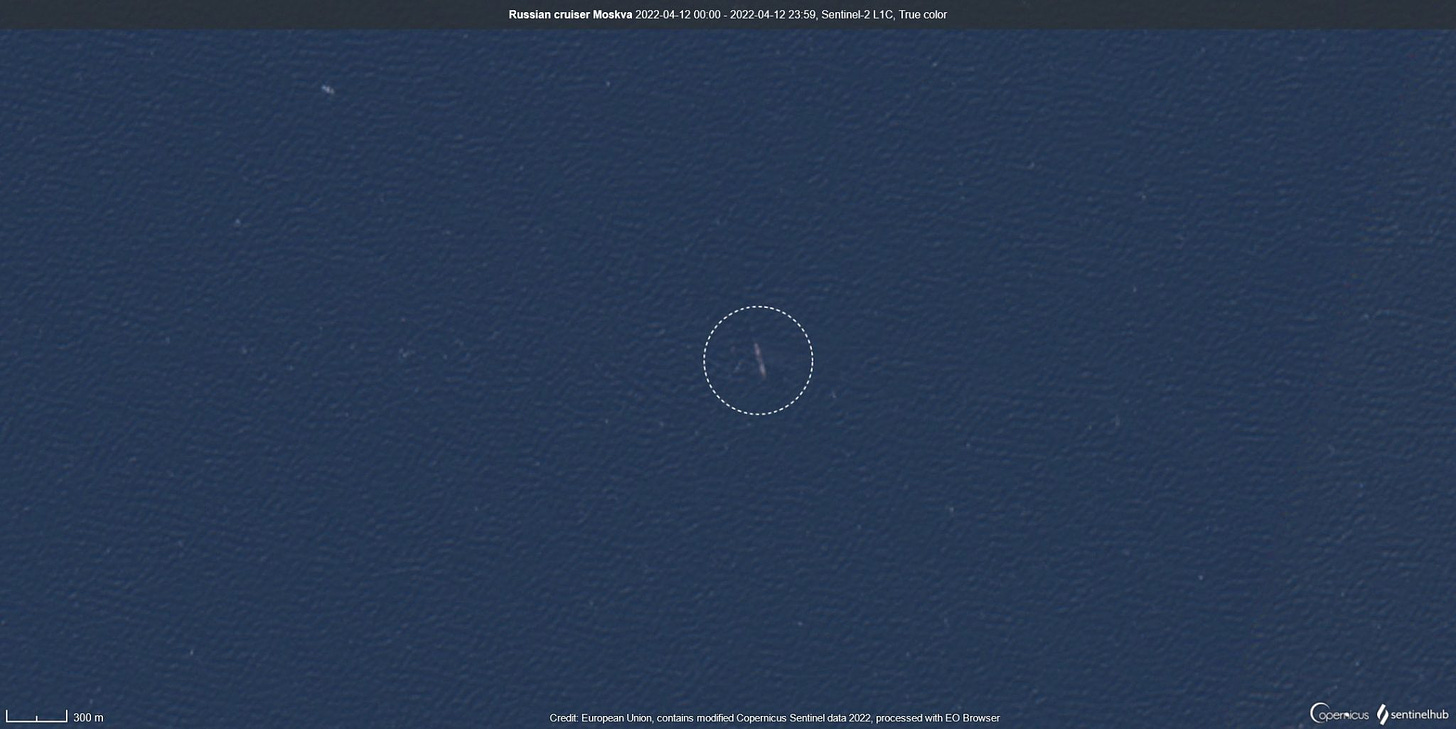
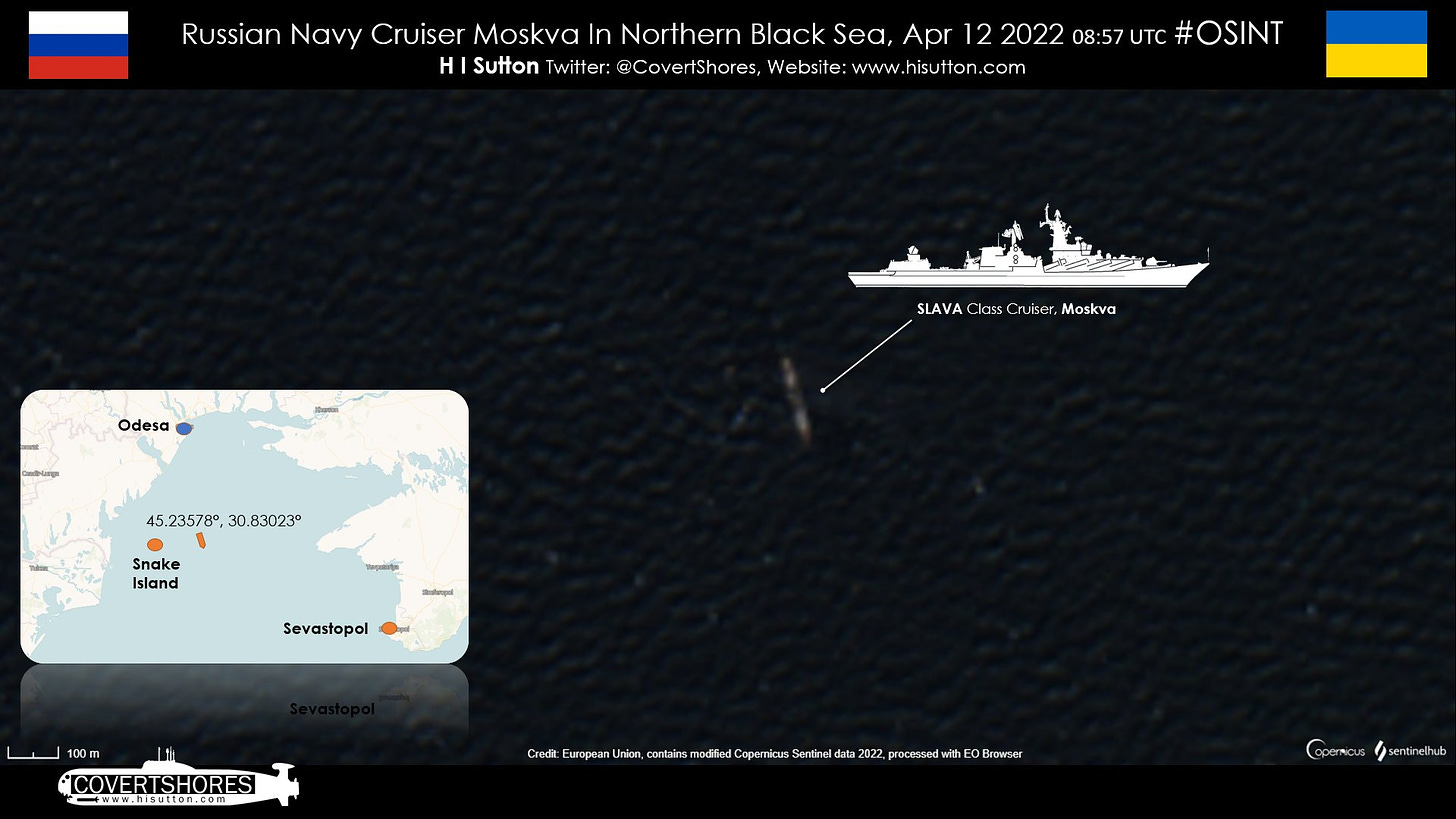

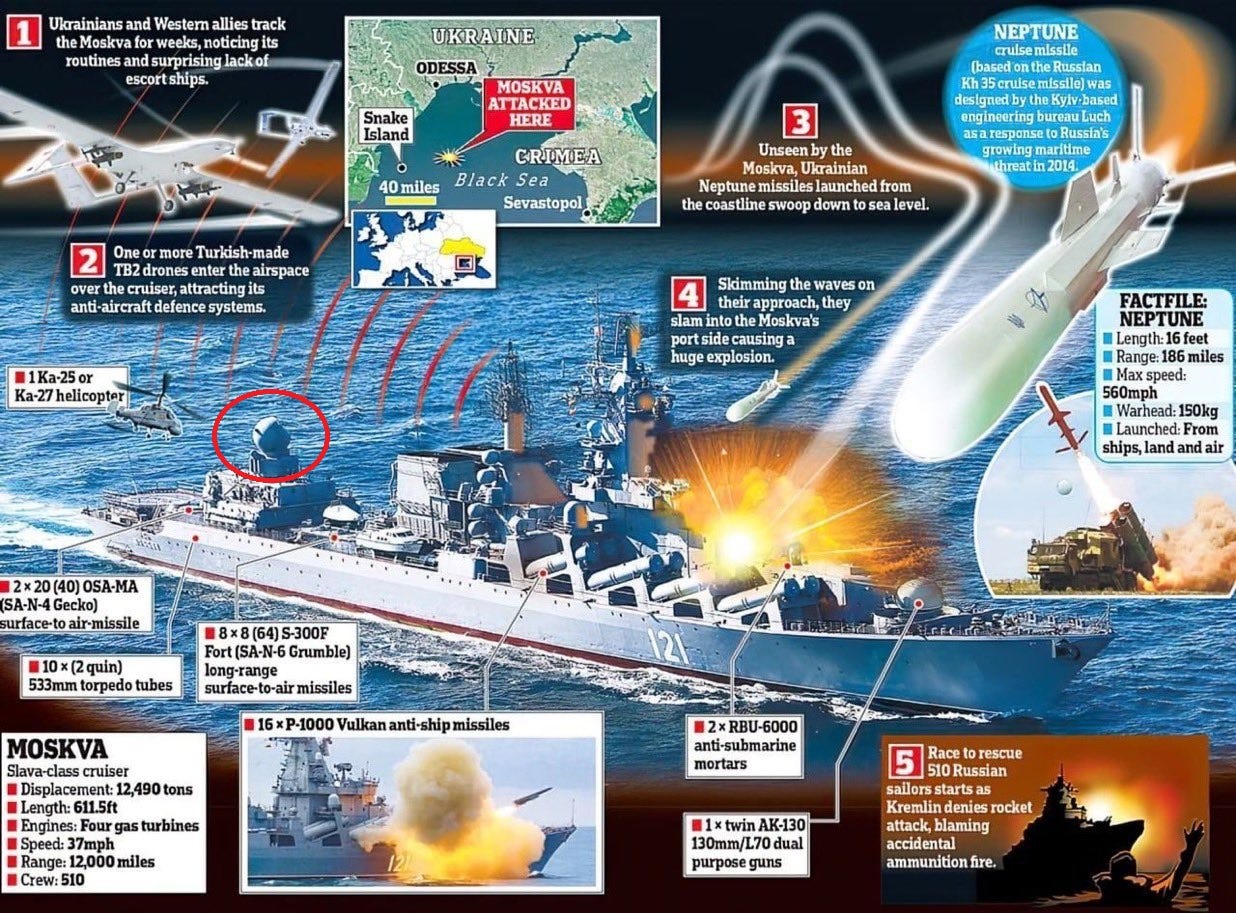
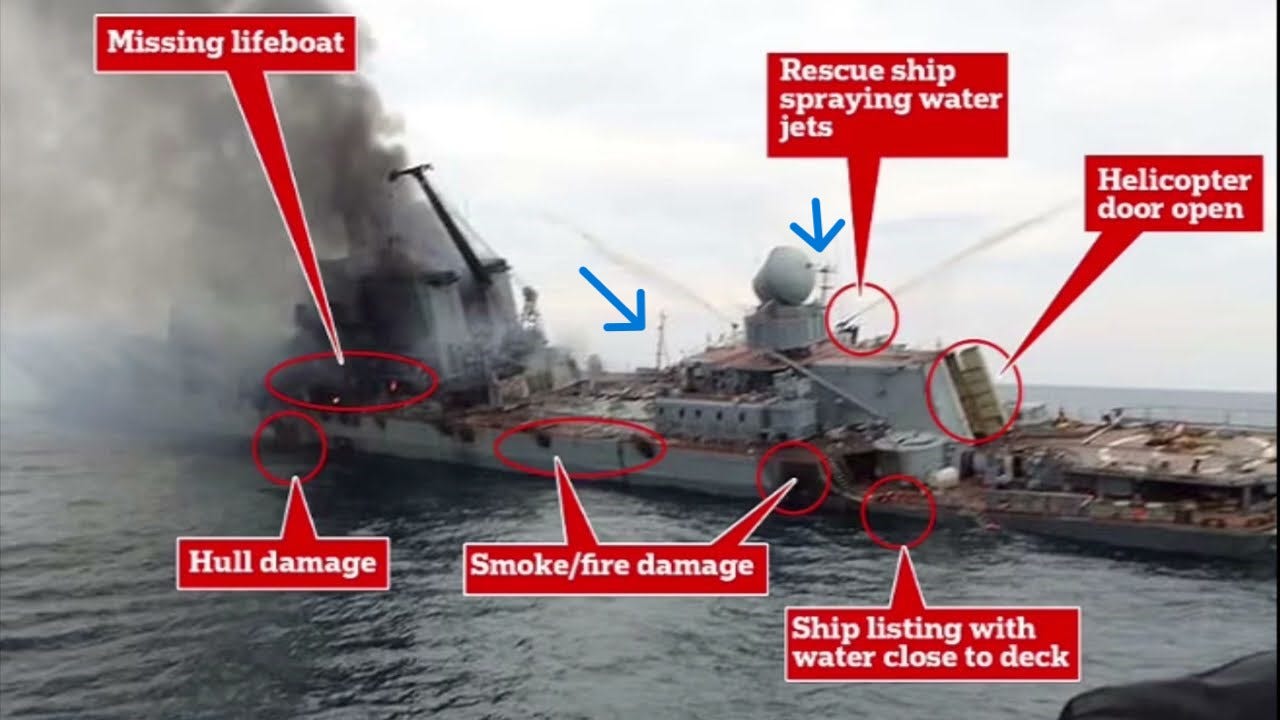
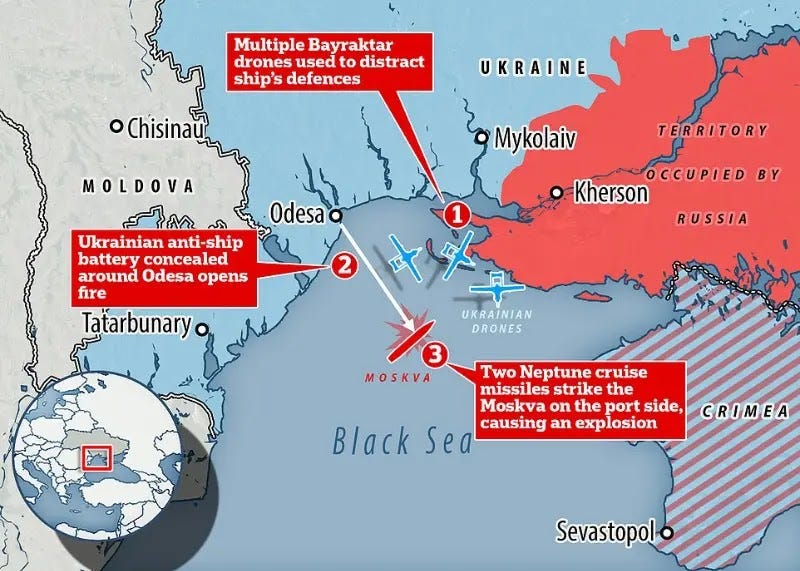
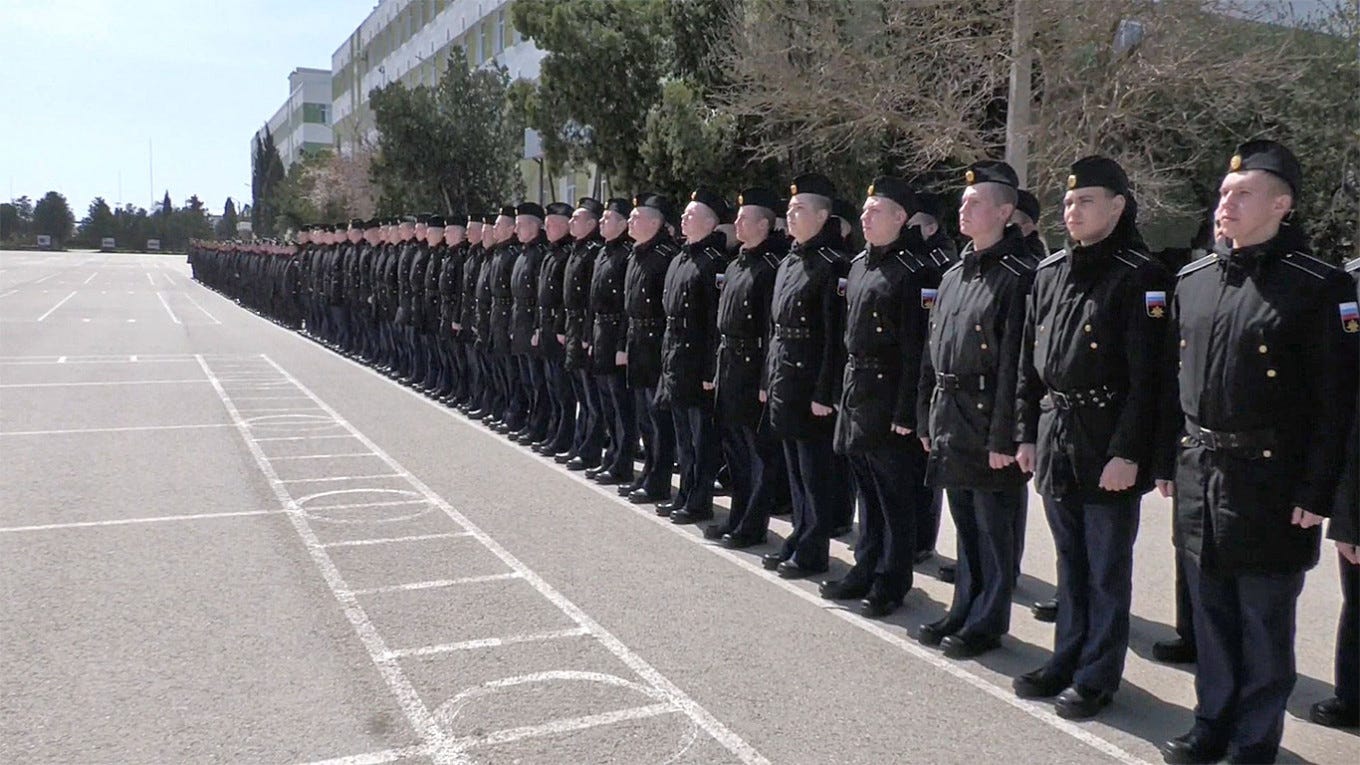
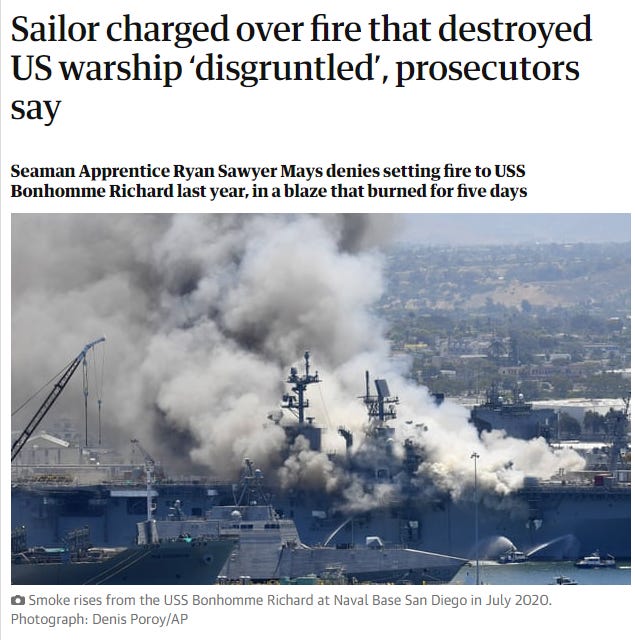

Nice recap of why Ukraine should never be believed about anything.
Once again, a superb analysis. And I've got two pieces of information that'll confirm your hard work.
First of all, I live about a 90-minute drive west of Odessa, so we basically have the same weather, except it does rain a tiny bit more intensely in Odessa than here for whatever reason. Well, guess what? This year, it was definitely a bit chilly and overcast on April 13. But last year? It was gorgeous weather (I remember because the Ukrainians attacked us several times in April, including on April 25 when they fired three RPG and blew up a building two blocks from where I lived), so that video was definitely shot THIS year.
Secondly, there are websites which record historical weather data (although most are US-only, so you got to wade through them and remember to spell the city "Odesa" because that's the "Ukrainian" spelling). Last year, on April 13 in Odessa there was not a drop of rain, and only half a millimeter (0.00000001 inches or whatever the US equivalent is) of rain the entire week before. If it was stormy at sea, it sure wasn't raining on land, and the winds were quite mild as well (30 km/h or less out of the south).
Third, I'll just add that there were plenty of Turkish ships near Odessa in those days - just not military ones. In and around the city of Odessa are three huge commercial sea ports that do a shit ton of business to/from Turkey. So it's definitely possible a commercial Turkish ship of some kind was in the vicinity of the Moskva.
In terms of sunrise and sunset, yep, that's all true for this part of the world. There's no friggin' way the sun was shining at 8pm in April.